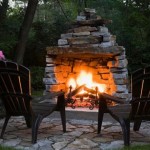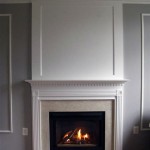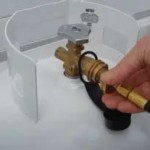Indoor Fire Pit Fireplace: A Guide to Design and Safety
Indoor fire pit fireplaces represent a compelling convergence of aesthetics and functionality, bringing the warmth and ambiance of an outdoor fire into the controlled environment of a home. These installations offer a unique focal point for living spaces, encouraging relaxation and socialization while potentially serving as a supplementary heating source. However, incorporating an indoor fire pit fireplace requires careful consideration of design, safety regulations, and ventilation requirements to ensure a secure and enjoyable experience.
The resurgence in popularity of indoor fire pit fireplaces stems from a desire to connect with natural elements within the built environment. As living spaces become increasingly minimalist and technologically driven, the inclusion of a primal element like fire introduces a sense of warmth and grounding. Furthermore, innovative designs and advancements in gas and electric fire pit technology make it feasible to integrate these features into diverse architectural styles, ranging from rustic to contemporary.
This article delves into the key aspects of indoor fire pit fireplaces, exploring various types, design considerations, safety protocols, and the regulatory landscape surrounding their installation. It aims to provide comprehensive information for homeowners and design professionals seeking to incorporate this unique feature into residential spaces.
Fuel Source and Ventilation Considerations
The selection of a fuel source is a fundamental decision in the design and installation of an indoor fire pit fireplace. The most common options include wood-burning, gas-powered (natural gas or propane), and electric alternatives. Each fuel source presents distinct advantages and drawbacks regarding aesthetics, cost, maintenance, and environmental impact.
Wood-burning fire pits offer the traditional ambiance of a real fire, complete with crackling sounds and authentic wood smoke aroma. However, they necessitate a functional chimney system for proper ventilation, which expels smoke and combustion byproducts outside the dwelling. The chimney must be correctly sized and installed to ensure effective draft and prevent backdrafting, which can introduce harmful gases into the living space. Moreover, wood-burning fire pits require a consistent supply of firewood and regular cleaning to remove ash and creosote buildup, a flammable substance that can pose a fire hazard.
Gas-powered fire pits offer a cleaner and more convenient alternative to wood. They eliminate the need for firewood storage and ash removal and can be ignited and extinguished with ease. Gas fire pits typically use natural gas or propane as fuel. Natural gas offers a continuous and often more affordable fuel supply, but it requires a connection to a gas line. Propane-fueled fire pits offer greater flexibility in placement as they rely on portable propane tanks, but these tanks require periodic refilling and safe storage.
While gas fire pits produce fewer emissions than wood-burning models, they still generate combustion byproducts, including carbon monoxide. Therefore, proper ventilation is crucial. Most gas-powered indoor fire pits require a vent-free system, which incorporates advanced burner technology to minimize emissions and utilize a catalytic converter to further reduce pollutants. These vent-free systems are subject to stringent safety standards and require professional installation to ensure proper operation.
Electric fire pits offer the simplest and cleanest option for indoor use. They do not produce any emissions and do not require ventilation. Electric fire pits operate by simulating the appearance of flames using LED lights and reflective materials. While they lack the authentic ambiance of a real fire, they offer a safe and convenient way to add visual warmth to a room. Electric fire pits are also energy-efficient and can be easily controlled with a remote or thermostat.
Regardless of the fuel source, adequate ventilation is paramount for safety. Even vent-free gas fire pits require a certain amount of air circulation to prevent the buildup of carbon monoxide. Local building codes often specify minimum ventilation requirements for indoor fire features. It is essential to consult with a qualified HVAC professional to determine the appropriate ventilation strategy for a specific installation.
Design Integration and Material Selection
Integrating an indoor fire pit fireplace into a home's design requires careful consideration of aesthetics, functionality, and spatial constraints. The fire pit must complement the existing architectural style and décor while providing a safe and comfortable gathering space. The size, shape, and placement of the fire pit will significantly impact the overall visual appeal and usability of the room.
Fire pit fireplaces can be designed as freestanding features or integrated into existing architectural elements, such as walls or floors. Freestanding fire pits offer greater flexibility in placement and can be easily moved or reconfigured. Integrated fire pits create a more permanent and seamless look, often serving as a focal point within a larger design scheme.
Material selection plays a crucial role in both the aesthetics and safety of an indoor fire pit fireplace. Common materials include stone, brick, concrete, metal, and glass. Each material offers a unique texture, color, and heat resistance. It is essential to choose materials that are non-combustible and capable of withstanding the high temperatures generated by the fire.
Stone and brick offer a classic and durable option for fire pit construction. They provide excellent heat resistance and can be incorporated into various architectural styles. Concrete offers a more modern and versatile option, allowing for custom shapes and finishes. Metal, such as stainless steel or copper, can be used to create sleek and contemporary fire pit designs. Glass can be used as a decorative element, adding visual interest and reflecting the flames.
The surrounding area around the fire pit should also be designed with safety in mind. Non-combustible materials, such as stone or tile, should be used for flooring and walls within a certain radius of the fire pit. Furniture should be placed at a safe distance to prevent accidental ignition. Adequate seating should be provided to accommodate guests comfortably.
Lighting can also enhance the ambiance of an indoor fire pit fireplace. Dimmer switches can be used to control the intensity of the lighting, creating a warm and inviting atmosphere. Accent lighting can be used to highlight architectural features or decorative elements around the fire pit.
Safety Regulations and Installation Procedures
The installation of an indoor fire pit fireplace is subject to stringent safety regulations and building codes. These regulations are designed to minimize the risk of fire, carbon monoxide poisoning, and other hazards. Compliance with these regulations is essential for ensuring the safety of the occupants and the structural integrity of the dwelling.
Before beginning any installation, it is crucial to obtain the necessary permits from the local building department. These permits typically require detailed plans and specifications for the fire pit, including the fuel source, ventilation system, and surrounding materials. The plans must be reviewed and approved by a building inspector to ensure compliance with all applicable codes.
The installation of a fire pit should be performed by qualified professionals who are familiar with the relevant building codes and safety standards. For wood-burning fire pits, a certified chimney sweep should inspect the chimney to ensure it is in good working order and free from obstructions. For gas-powered fire pits, a licensed plumber or gas fitter should install the gas line and connect the fire pit to the gas supply.
Carbon monoxide detectors should be installed throughout the home, particularly near sleeping areas. These detectors provide an early warning of carbon monoxide buildup, allowing occupants to evacuate the premises before dangerous levels are reached. The detectors should be tested regularly and replaced according to the manufacturer's instructions.
A fire extinguisher should be readily accessible near the fire pit. The extinguisher should be rated for Class ABC fires, which are common in residential settings. Occupants should be familiar with the proper use of the fire extinguisher. It is also advisable to have a fire blanket on hand to smother small fires.
Regular maintenance is essential for ensuring the safe and efficient operation of an indoor fire pit fireplace. Wood-burning fire pits should be cleaned regularly to remove ash and creosote buildup. Gas-powered fire pits should be inspected for gas leaks and burner malfunctions. Electric fire pits should be inspected for electrical damage and loose connections.
Finally, it is important to educate all occupants of the home about the safe use of the fire pit. This includes instructions on how to ignite and extinguish the fire, proper ventilation procedures, and emergency protocols. By following these safety regulations and installation procedures, homeowners can enjoy the warmth and ambiance of an indoor fire pit fireplace without compromising safety.

Indoor Fire Pit Rustic Style Home Decor

My Favorite Fireplace Indoor Fire Pit Glass

Indoor Wood Fireplace Hanging Fire Pit Place Design China Made In Com

Cosy Fireplace At Hotel Premiere Nations Freestanding

A Chimney Less Fire Pit For The Indoors Core77

Fireplace Envy Rears Its Head As Seasons Shift Indoor Fire Pit Outdoor Furniture

Fire Pits Fireplaces And Pit Glass Starfire Direct

Cosmo 50 Outdoor Fireplace By Ecosmart Fire

53 Most Amazing Outdoor Fireplace Designs Ever Modern Indoor Fireplaces Fire Pit

Why You Should Invest In An Indoor Fire Pit Outdoor Living Essentials
Related Posts








